Galaxy Clusters

A Minuet of Galaxies
This troupe of four galaxies, known as Hickson Compact Group 87 (HCG 87), is performing an intricate dance orchestrated by the mutual gravitational forces acting between them. The dance is a slow, graceful minuet, occurring over a time span of hundreds of millions of years.
The Wide Field and Planetary Camera 2 on NASA's Hubble Space Telescope (HST) provides a striking improvement in resolution over previous ground-based imaging. In particular, this image reveals complex details in the dust lanes of the group's largest galaxy member (HCG 87a), which is actually disk-shaped, but tilted so that we see it nearly edge-on. Both 87a and its elliptically shaped nearest neighbor (87b) have active galactic nuclei which are believed to harbor black holes that are consuming gas. A third group member, the nearby spiral galaxy 87c, may be undergoing a burst of active star formation. Gas flows within galaxies can be intensified by the gravitational tidal forces between interacting galaxies. So interactions can provide fresh fuel for both active nuclei and starburst phenomena. These three galaxies are so close to each other that gravitational forces disrupt their structure and alter their evolution.
From the analysis of its spectra, the small spiral near the center of the group could either be a fourth member or perhaps an unrelated background object.
The HST image was made by combining images taken in four different color filters in order to create a three-color picture. Regions of active star formation are blue (hot stars) and also pinkish if hot hydrogen gas is present. The complex dark bands across the large edge-on disk galaxy are due to interstellar dust silhouetted against the galaxy's background starlight. A faint tidal bridge of stars can be seen between the edge-on and elliptical galaxies.
HCG 87 was selected for Hubble imaging by members of the public who visited the Hubble Heritage website during the month of May and registered their votes. The HST exposures of the winning target were then acquired in July 1999 by the Hubble Heritage Team and guest astronomers Sally Hunsberger (Lowell Observatory, Flagstaff, Arizona) and Jane Charlton (Pennsylvania State University).
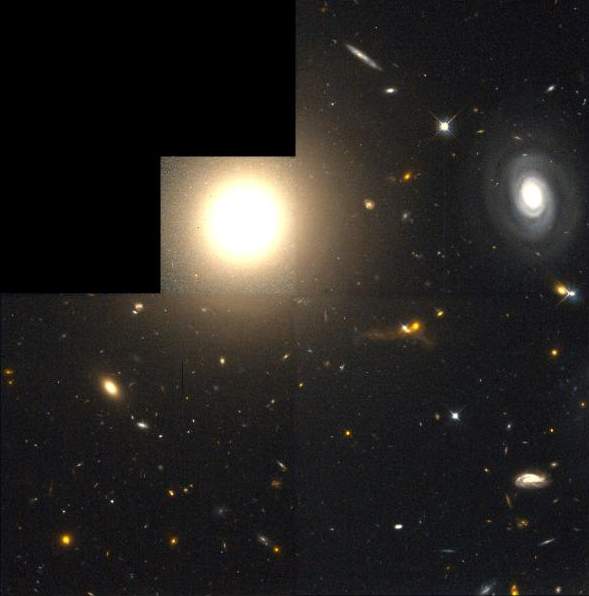
NGC 4881 and Part of the Surrounding Field
This photo mosaic, which shows a field of distant galaxies, is a computer enhanced reproduction of a picture taken 4 March 1994 with the repaired Hubble Space Telescope. It combines 16 exposures of 15 minutes each, taken through two filters (F555W and F814W) with the Wide Field Planetary Camera 2. The HST WFPC2 field is chevron-shaped, because it is a mosaic of images recorded with three Wide Field cameras and one higher resolution camera (Planetary Camera) in the upper left.
The brightest object in this picture is NGC 4881, approximately centered here in the Planetary Camera (the small quadrant). It is a 13th-magnitude elliptical galaxy in the outskirts of the Coma Cluster, a great cluster of galaxies more than 5 times farther away than the Virgo Cluster. The radical velocity (redshift) of NGC 4881, based on the Doppler displacement of lines in its spectrum, is about 7000 km/sec. Except for a 16th-magnitude Coma spiral at the right and a few foreground stars of the Milky Way, nearly everything else in this field lies far beyond the Coma Cluster. There is a fascinating assortment of background galaxies, including an apparent galaxian merger in progress.
Purpose: This HST-WFPC2 observation was made to explore the use the globular star clusters surrounding NGC 4881 as distance indicators for inferring the distance to the Coma Cluster. They are barely visible point sources in this reproduction. The distance to the Coma Cluster is an important cosmic yardstick for scaling the over all size of the universe, because Coma (unlike Virgo) is far enough away that regional departures from a smooth expansion of the universe should not be a major source of uncertainty if Coma is used for estimating the age and rate of expansion (the Hubble Constant).
The brightness distribution of globular clusters has been studied in a number of nearer galaxies. They are most numerous between -7 and -8 absolute magnitude. In the Milky Way they peak at -7.6 absolute magnitude. We must find that peak ("turnover") in NGC 4881 in order to judge the distance. Within statistical uncertainties, the number of globulars per magnitude in NGC 4881 increases down to our present threshold of 27.6 magnitude. We do not yet see evidence of the turnover in NGC 4881, which suggests that the Coma Cluster may be more than 100 megaparsecs away and that the Hubble Constant may therefore be less than 70 km/sec per megaparsec. The adding together of more exposures will evidently be needed to reach a fainter threshold and find the turnover. Though not yet definitive in itself, this exploratory observation of NGC 4881 shows that it is within the reach of HST to obtain a definitive globular-cluster distance to the Coma Cluster and an associated value of the Hubble Constant.

Abell 2218, A Cosmic Magnifying Glass
This massive cluster resides in the constellation Draco, some 2 billion light-years from Earth.
The cluster is so massive that its enormous gravitational field deflects light rays passing through it, much as an optical lens bends light to form an image. This phenomenon, called gravitational lensing, magnifies, brightens, and distorts images from faraway objects. The cluster's magnifying powers provides a powerful "zoom lens" for viewing distant galaxies that could not normally be observed with the largest telescopes.
This useful phenomenon has produced the arc-shaped patterns found throughout the Hubble picture. These "arcs" are the distorted images of very distant galaxies, which lie 5 to 10 times farther than the lensing cluster. This distant population existed when the universe was just a quarter of its present age. Through gravitational lensing these remote objects are magnified, enabling scientists to study them in more detail. This analysis provides a direct glimpse of how star-forming regions are distributed in remote galaxies and yields other clues to the early evolution of galaxies.
The picture is dominated by spiral and elliptical galaxies. Resembling a string of tree lights, the biggest and brightest galaxies are members of the foreground cluster. Researchers are intrigued by a tiny red dot just left of top center. This dot may be an extremely remote object made visible by the cluster's magnifying powers. Further investigation is needed to confirm the object's identity.
The Hubble telescope first viewed this cluster in 1994, producing one of the most spectacular demonstrations of gravitational lensing up to that time. Scientists who analyzed that black-and-white picture discovered more than 50 remote, young galaxies. Hubble's latest multicolor image of the cluster will allow astronomers to probe in greater detail the internal structure of these early galaxies. The color picture already reveals several arc-shaped features that are embedded in the cluster and cannot be easily seen in the black-and-white image.
The colors in this picture yield clues to the ages, distances, and temperatures of stars, the stuff of galaxies. Blue pinpoints hot young stars. The yellow-white color of several of the galaxies represents the combined light of many stars. Red identifies cool stars, old stars, and the glow of stars in distant galaxies. This view is only possible by combining Hubble's unique image quality with the rare lensing effect provided by the magnifying cluster.
The picture was taken Jan. 11 to 13, 2000, with the Wide Field and Planetary Camera 2.
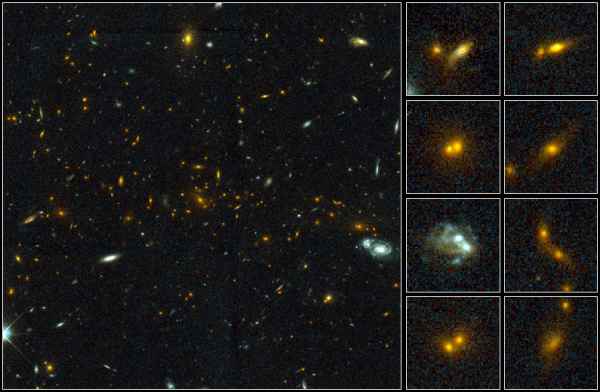
Galaxy Collisions in Distant Cluster
The group of galaxies, catalogued as MS1054-03, is 8 billion light-years away, one of the most distant known so far. Although hundreds of galaxies appear in the NASA/ESA Hubble Space Telescope image, a European-led team of astronomers has studied in detail 81 galaxies that certainly belong to the cluster, 13 of which are remnants of recent collisions or pairs of colliding galaxies. This is by far the largest number of colliding galaxies ever found in a cluster.
The picture is actually a "mosaic" of images, so that astronomers can have a much wider view of the distant cluster. This is why the colliding galaxies, mostly located in clumps in the outskirts of the cluster, had not been discovered so far.
In the image, streams of stars can be seen being pulled out of the galaxies, a consequence of the huge tidal forces in action. The red color of most of the merger remnants means that the stars are old and not much star formation has "recently" taken place.
The observations with the Hubble were made in May 1998. The 10-meter Keck telescope in Hawaii was used to confirm that the colliding galaxies were part of the cluster.
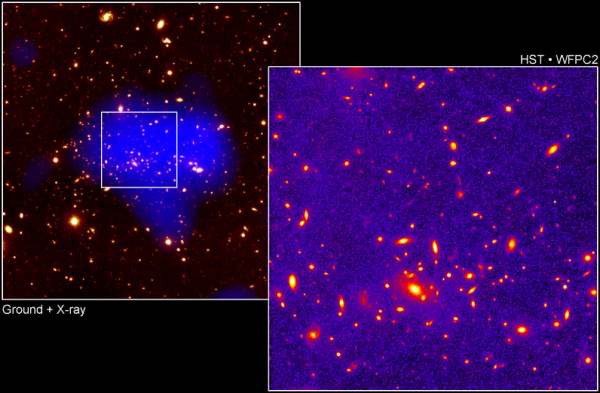
Telescopes Unveil View of Remote, Massive Galaxy Cluster
These images, taken by three different telescopes, show the distant, hefty galaxy cluster MS1054-0321, containing thousands of galaxies and trillions of stars. Weighing the equivalent of several thousand of our Milky Ways, the cluster is 8 billion light-years from Earth.
The image on the left is a color composite taken by ground-based and X-ray observatories showing the entire galaxy cluster surrounded by background and foreground galaxies. The blue color in the center of the image represents the huge amount of hot gas that fills the space between the galaxies in the cluster. This gas - colored blue - cannot be seen in visible light, but glows in X-ray frequencies. Astronomers have measured its temperature at 300 million degrees Fahrenheit. The X-ray information was used to estimate the cluster's total mass.
The boxed area in the center of the image pinpoints the Hubble telescope's field of view. The image on the right, taken by the Wide Field and Planetary Camera 2, shows a clearer view of the galaxies in the heart of the cluster. The width of this massive cluster is a few million light-years.
The ground-based image was taken between May 1992 and November 1993 by the 88-inch telescope at the University of Hawaii. Astronomers Isabella Gioia and Gerry Luppino of the University of Hawaii made this four-hour exposure with a near-infrared filter (8,000 angstroms).
The X-ray image was taken in 1996 by astronomer Megan Donahue of the Space Telescope Science Institute with the High Resolution Imager aboard the Rosat satellite. The exposure time was 34 hours.
Donahue used a near-infrared filter (F814W) to take the Hubble telescope image in 1996. The exposure time was four hours.
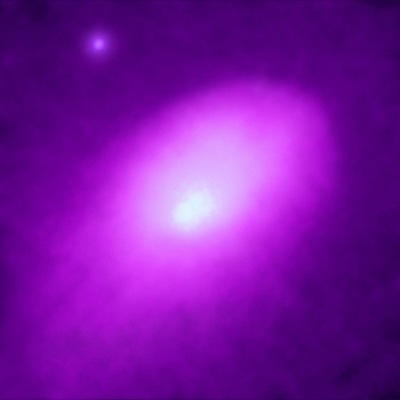
Chandra Maps Cosmic Pressure Fronts
This Chandra X-ray Observatory image of the galaxy cluster Abell 2142 shows a colossal cosmic "weather system" produced by the collision of two giant clusters of galaxies. For the first time, the pressure fronts in the system can be traced in detail, and they show a bright, but relatively cool 50 million degree central region (white) embedded in large elongated cloud of 70 million degree gas (magenta), all of which is roiling in a faint atmosphere of 100 million degree gas (faint magenta and dark blue). The bright source in the upper left is an active galaxy in the cluster.
Abell 2142 is six million light years across and contains hundreds of galaxies and enough gas to make a thousand more. It is one of the most massive objects in the universe. Galaxy clusters grow to vast sizes as smaller clusters are pulled inward under the influence of gravity. They collide and merge over the course of billions of years, releasing tremendous amounts of energy that heats the cluster gas. The smoothness of the elongated cloud in the Chandra image suggests that these sub-clusters have collided two or three times in a billion years or more, and have nearly completed their merger.
The image is by the Chandra X-ray Observatory Advanced CCD Imaging Spectrometer(ACIS)

Gravitational Lens Helps Hubble and Keck Discover Galaxy Building Block
Acknowledgment: NASA, A. Fruchter and the ERO Team (STScI and ST-ECF)
This NASA Hubble Space Telescope image shows a very small, faint galaxy 'building block' newly discovered by a unique collaboration between ground- and space-based telescopes. Hubble and the 10-meter Keck Telescopes in Hawaii joined forces, using a galaxy cluster which acts as gravitational lens to detect what scientists believe is one of the smallest very distant objects ever found.
The galaxy cluster Abell 2218 was used by a team of European and American astronomers led by Richard Ellis (Caltech) in their systematic search for intrinsically faint distant star-forming systems. Without help from Abell 2218's exceptional magnifying power to make objects appear about 30 times brighter, the galaxy building block would have been undetectable.
In the image to the right, the object is seen distorted into two nearly identical, very red 'images' by the gravitational lens. The image pair represents the magnified result of a single background object gravitationally lensed by Abell 2218 and viewed at a distance of 13.4 billion light-years. The intriguing object contains only one million stars, far fewer than a mature galaxy, and scientists believe it is very young. Such young star-forming systems of low mass at early cosmic times are likely to be the objects from which present-day galaxies have formed.
In the image to the left, the full overview of the galaxy cluster Abell 2218 is seen. This image was taken by Hubble in 1999 at the completion of Hubble Servicing Mission 3A.

Abell 1689, Biggest 'Zoom Lens' in Space
A massive cluster of yellowish galaxies, seemingly caught in a red and blue spider web of eerily distorted background galaxies, makes for a spellbinding picture from the new Advanced Camera for Surveys aboard NASA's Hubble Space Telescope. To make this unprecedented image of the cosmos, Hubble peered straight through the center of one of the most massive galaxy clusters known, called Abell 1689. The gravity of the cluster's trillion stars — plus dark matter — acts as a 2-million-light-year-wide "lens" in space. This "gravitational lens" bends and magnifies the light of the galaxies located far behind it. Some of the faintest objects in the picture are probably over 13 billion light-years away (redshift value 6).
Though gravitational lensing has been studied previously by Hubble and ground-based telescopes, this phenomenon has never been seen before in such detail. The ACS picture reveals 10 times more arcs than would be seen by a ground-based telescope. The ACS is 5 times more sensitive and provides pictures that are twice as sharp as the previous work-horse Hubble cameras. So it can see the very faintest arcs with greater clarity. The picture presents an immense jigsaw puzzle for Hubble astronomers to spend months untangling. Interspersed with the foreground cluster are thousands of galaxies, which are lensed images of the galaxies in the background universe. Detailed analysis of the images promises to shed light on galaxy evolution, the curvature of space, and the mystery of dark matter. The picture is an exquisite demonstration of Albert Einstein's prediction that gravity warps space and distorts beams of light.
This representative color image is a composite of visible-light and near-infrared exposures taken in June 2002.
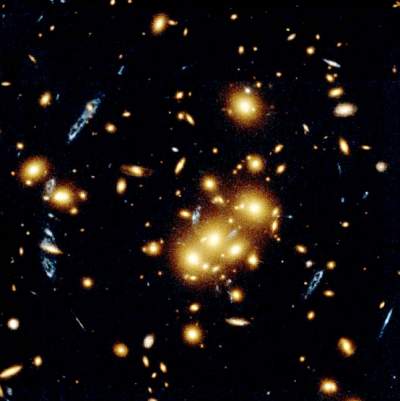
Gravitational Lens Captures Image of Primeval Galaxy
This Hubble Space Telescope image shows several blue, loop-shaped objects that actually are multiple images of the same galaxy. They have been duplicated by the gravitational lens of the cluster of yellow, elliptical and spiral galaxies - called 0024+1654 - near the photograph's center. The gravitational lens is produced by the cluster's tremendous gravitational field that bends light to magnify, brighten and distort the image of a more distant object. How distorted the image becomes and how many copies are made depends on the alignment between the foreground cluster and the more distant galaxy, which is behind the cluster.
In this photograph, light from the distant galaxy bends as it passes through the cluster, dividing the galaxy into five separate images. One image is near the center of the photograph; the others are at 6, 7, 8, and 2 o'clock. The light also has distorted the galaxy's image from a normal spiral shape into a more arc-shaped object. Astronomers are certain the blue-shaped objects are copies of the same galaxy because the shapes are similar. The cluster is 5 billion light-years away in the constellation Pisces, and the blue-shaped galaxy is about 2 times farther away.
Though the gravitational light-bending process is not new, Hubble's high resolution image reveals structures within the blue-shaped galaxy that astronomers have never seen before. Some of the structures are as small as 300 light-years across. The bits of white imbedded in the blue galaxy represent young stars; the dark core inside the ring is dust, the material used to make stars. This information, together with the blue color and unusual "lumpy" appearance, suggests a young, star-making galaxy.
The picture was taken October 14, 1994 with the Wide Field Planetary Camera-2. Separate exposures in blue and red wavelengths were taken to construct this color picture.
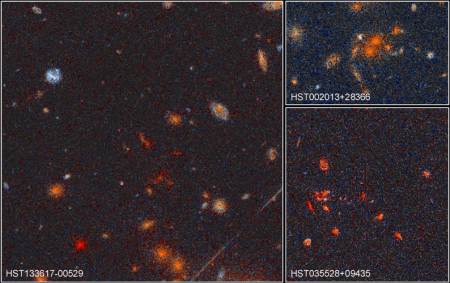
Far-Flung Galaxy Clusters May Reveal Fate of Universe
A selection of NASA Hubble Space Telescope snapshots of huge galaxy clusters that lie far away and far back in time. These are selected from a catalog of 92 new clusters uncovered during a six-year Hubble observing program known as the Medium Deep Survey.
If the distances and masses of the clusters are confirmed by ground based telescopes, the survey may hold clues to how galaxies quickly formed into massive large-scale structures after the big bang, and what that may mean for the eventual fate of the expanding universe.
The images are each a combination of two exposures in yellow and deep red taken with Hubble's Wide Field and Planetary Camera 2. Each cluster's distance is inferred from the reddening of the starlight, which is due to the expansion of space. Astronomers assume these clusters all formed early in the history of the universe.
HST133617-00529 (left)
This collection of spiral and elliptical galaxies lies an estimated 4 to 6 billion light-years away. It is in the constellation of Virgo not far from the 3rd magnitude star Zeta Virginis. The brighter galaxies in this cluster have red magnitudes between 20 and 22 near the limit of the Palomar Sky Survey. The bright blue galaxy (upper left) is probably a foreground galaxy, and not a cluster member. The larger of the galaxies in the cluster are probably about the size of our Milky Way Galaxy. The diagonal line at lower right is an artificial satellite trail.
HST002013+28366 (upper right)
This cluster of galaxies lies in the constellation of Andromeda a few degrees from the star Alpheratz in the northeast corner of the constellation Pegasus. It is at an estimated distance of 4 billion light-years, which means the light we are seeing from the cluster is as it appeared when the universe was roughly 2/3 of its present age.
HST035528+09435 (lower right)
At an estimated distance of about 7 to 10 billion light-years (z=1), this is one of the farthest clusters in the Hubble sample. The cluster lies in the constellation of Taurus.
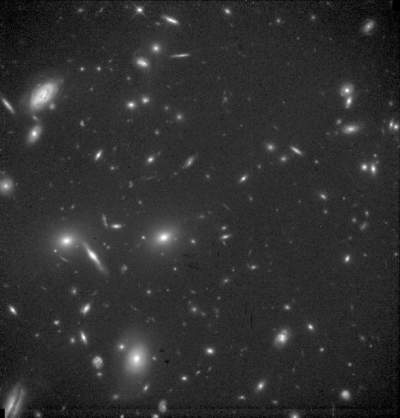
The Lost Ancestors to Our Milky Way Galaxy
This NASA Hubble Space Telescope (HST) image of the central portion of a remote cluster of galaxies (CL 0939+4713) as it looked when the universe was two-thirds of its present age. Hubble's high resolution allows astronomers to study, for the first time, the shapes of galaxies as they were long ago.
The Space Telescope pictures are sharp enough to distinguish between various forms of spiral galaxies. Most of the spiral, or disk, galaxies have odd features, suggesting they were easily distorted within the environment of the rich cluster. Hubble reveals a number of mysterious "fragments" of galaxies interspersed through the cluster.
The HST picture confirms that billions of years ago, clusters of galaxies contained not only the types of galaxies dominating their descendant clusters today, but also several times as many spiral galaxies. These spiral galaxies have since disappeared through mergers and disruptions, as evident in the Hubble image.
This visible light image was taken with HST's Wide Field Planetary Camera 2 in Wide Field Camera mode, on January 10 and 12, 1994.
 CosmicLight.com Home
CosmicLight.com Home